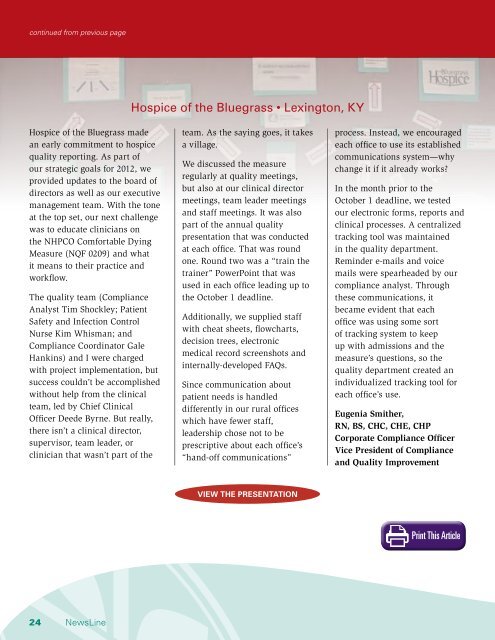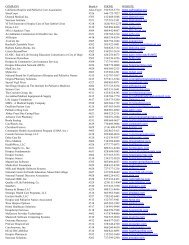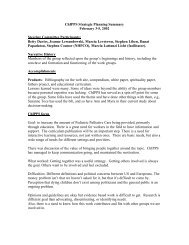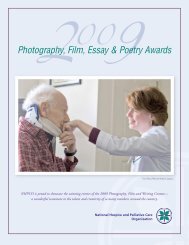PDF version - National Hospice and Palliative Care Organization
PDF version - National Hospice and Palliative Care Organization
PDF version - National Hospice and Palliative Care Organization
You also want an ePaper? Increase the reach of your titles
YUMPU automatically turns print PDFs into web optimized ePapers that Google loves.
continued from previous page<br />
<strong>Hospice</strong> of the Bluegrass • Lexington, KY<br />
<strong>Hospice</strong> of the Bluegrass made<br />
an early commitment to hospice<br />
quality reporting. As part of<br />
our strategic goals for 2012, we<br />
provided updates to the board of<br />
directors as well as our executive<br />
management team. With the tone<br />
at the top set, our next challenge<br />
was to educate clinicians on<br />
the NHPCO Comfortable Dying<br />
Measure (NQF 0209) <strong>and</strong> what<br />
it means to their practice <strong>and</strong><br />
workflow.<br />
The quality team (Compliance<br />
Analyst Tim Shockley; Patient<br />
Safety <strong>and</strong> Infection Control<br />
Nurse Kim Whisman; <strong>and</strong><br />
Compliance Coordinator Gale<br />
Hankins) <strong>and</strong> I were charged<br />
with project implementation, but<br />
success couldn’t be accomplished<br />
without help from the clinical<br />
team, led by Chief Clinical<br />
Officer Deede Byrne. But really,<br />
there isn’t a clinical director,<br />
supervisor, team leader, or<br />
clinician that wasn’t part of the<br />
team. As the saying goes, it takes<br />
a village.<br />
We discussed the measure<br />
regularly at quality meetings,<br />
but also at our clinical director<br />
meetings, team leader meetings<br />
<strong>and</strong> staff meetings. It was also<br />
part of the annual quality<br />
presentation that was conducted<br />
at each office. That was round<br />
one. Round two was a “train the<br />
trainer” PowerPoint that was<br />
used in each office leading up to<br />
the October 1 deadline.<br />
Additionally, we supplied staff<br />
with cheat sheets, flowcharts,<br />
decision trees, electronic<br />
medical record screenshots <strong>and</strong><br />
internally-developed FAQs.<br />
Since communication about<br />
patient needs is h<strong>and</strong>led<br />
differently in our rural offices<br />
which have fewer staff,<br />
leadership chose not to be<br />
prescriptive about each office’s<br />
“h<strong>and</strong>-off communications”<br />
process. Instead, we encouraged<br />
each office to use its established<br />
communications system—why<br />
change it if it already works?<br />
In the month prior to the<br />
October 1 deadline, we tested<br />
our electronic forms, reports <strong>and</strong><br />
clinical processes. A centralized<br />
tracking tool was maintained<br />
in the quality department.<br />
Reminder e-mails <strong>and</strong> voice<br />
mails were spearheaded by our<br />
compliance analyst. Through<br />
these communications, it<br />
became evident that each<br />
office was using some sort<br />
of tracking system to keep<br />
up with admissions <strong>and</strong> the<br />
measure’s questions, so the<br />
quality department created an<br />
individualized tracking tool for<br />
each office’s use.<br />
Eugenia Smither,<br />
RN, BS, CHC, CHE, CHP<br />
Corporate Compliance Officer<br />
Vice President of Compliance<br />
<strong>and</strong> Quality Improvement<br />
VIEW THE PRESENTATION<br />
24 NewsLine









